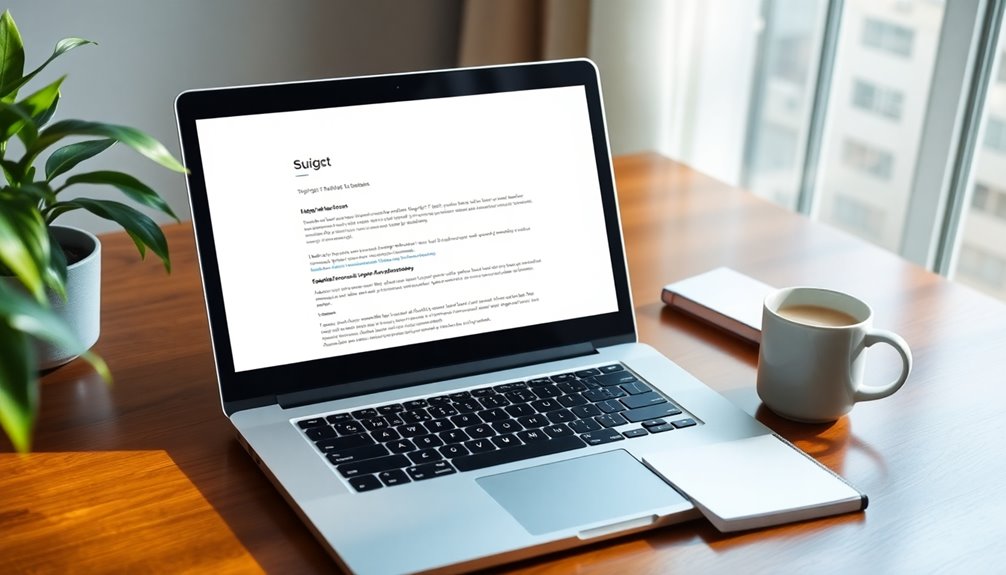To write a business email that seals the deal, you need to be clear and engaging. Start with a personalized approach to boost open rates by 26%. Keep your subject line concise and your content direct. End with a strong call to action, like "Schedule a call" to encourage quick responses. Follow up within 24 hours, referencing previous interactions to maintain connection. Make your emails concise—ideally between 30-150 words—to respect your recipient's time. By following these tips, you'll enhance your chances of closing deals and fostering lasting relationships, and there's even more to discover!
Key Takeaways
- Craft a personalized subject line that captures attention and reflects the email's purpose to increase open rates.
- Begin with a clear objective that outlines the email's purpose and desired outcome, guiding the recipient's expectations.
- Maintain brevity by keeping the email concise (30-150 words), respecting the recipient's time and enhancing engagement.
- Use a strong, clear call-to-action (CTA) at the end, encouraging the recipient to take the next step, such as scheduling a call.
- Incorporate relevant testimonials or success stories to build credibility and persuade the recipient of your value.
Introduction

Writing a successful business email starts with understanding its importance in communication and sales. A well-crafted email can significantly influence conversion rates, especially since 80% of sales require at least five follow-ups to close a deal. This means each email you send has the potential to bring you one step closer to sealing the deal. Effective communication skills, such as clarity and conciseness, are invaluable in making your emails resonate with recipients. Additionally, high-quality content in your emails can enhance credibility and trustworthiness, making your message more persuasive. Moreover, utilizing time management apps can help streamline the process of drafting and sending your emails efficiently. Furthermore, the integration of automation technologies in business communication can increase efficiency and help you manage follow-ups effectively.
Personalization is key in your emails. Tailoring your messages to reflect your client's specific needs and challenges boosts engagement and shows you truly understand their situation.
Keep your emails concise and clear to enhance readability; shorter proposals often win more prospects. Remember, the nature of great speakers can inspire your writing style and help convey your message more effectively.
Don't forget the subject line! A concise, descriptive subject that reflects the content of your email can dramatically improve open rates and increase the likelihood of engagement.
Finally, always include a strong call-to-action in your emails. This encourages immediate responses and helps guide your recipients to the next steps in the sales process. Additionally, consider the importance of retirement savings options to ensure you're prepared for future financial needs while engaging in business communications.
Boosts Response Rates Significantly

A well-crafted business email can boost your response rates significantly. Personalized emails can lead to a 26% increase in open rates, which means more potential clients are engaging with your message.
To maximize this, ensure your subject line is clear and concise, ideally between 9-60 characters, so it quickly conveys the purpose of your email. Additionally, understanding your audience's wealth management needs can further tailor your messaging and increase engagement. Incorporating a strong focus on vibrational alignment can enhance the positivity conveyed in your emails, making them more appealing to the reader. Furthermore, utilizing A/B testing can help you refine your subject lines and content for better performance. Content that builds topical authority can further solidify your credibility and encourage higher response rates.
Incorporating a strong call to action (CTA) encourages immediate responses, which can enhance engagement and even lead to a 20% increase in sales. You can also utilize A/B testing for subject lines and content to refine your approach based on real-time feedback, ensuring you're hitting the mark with your audience.
Don't underestimate the power of follow-up emails. Sending them within 24 hours of a meeting can keep the momentum going and significantly improve your chances of closing deals. By staying in touch, you reinforce communication and show your commitment, which can make all the difference in securing a positive response. Additionally, using advanced segmentation techniques allows you to tailor your messaging even further, ensuring that your emails resonate with specific audience segments.
Strong Call to Action

Crafting a strong call to action (CTA) can significantly enhance your email's effectiveness. A well-defined CTA provides clear instructions, directing your recipient on exactly what you want them to do next. For instance, using phrases like "Schedule a call" or "Download now" not only clarifies the action but also increases engagement by up to 80% (HubSpot). Additionally, ensuring that your email is secure can help build trust, as users are more likely to respond positively when they feel their information is safe from cybersecurity vulnerabilities. Implementing a disciplined investment strategy can similarly guide recipients toward making informed decisions in uncertain situations. Furthermore, leveraging AI security technologies can help protect sensitive data, further enhancing trust and response rates.
To boost your response rates, consider incorporating a sense of urgency. Phrases such as "limited time offer" or "reply by [date]" can prompt quicker responses. Placing your CTA at the end of the email reinforces your main points and ensures clarity about the desired action.
Personalization is another key factor. Aligning your CTA with the recipient's interests or previous discussions can significantly enhance its effectiveness, leading to a 26% higher open rate (Campaign Monitor). Engaging with community forums can also provide insights that might resonate with your recipient, making your CTA more compelling.
Step-by-Step Guide to Writing Follow-Up Emails

After wrapping up a meeting or conversation, sending a follow-up email is crucial for reinforcing connections and moving discussions forward.
Ideally, you should send your follow-up message within 24 hours to maintain engagement and showcase your professionalism. Start by personalizing your email; refer to specific details from your prior interaction to make your recipient feel valued.
Next, establish a clear objective for your follow-up. Whether you're thanking them for their time, proposing next steps, or seeking feedback, clarity will streamline communication. This ensures that your recipient understands exactly what you need from them.
Keep your follow-up email concise and focused, ideally between 75-100 words. This shows respect for their time while delivering your message effectively. Additionally, remember that incorporating actionable tips can significantly enhance the effectiveness of your follow-up communication.
Dos and Don'ts for Follow-Ups

Effective follow-ups can be the key to maintaining momentum in your professional relationships. When crafting a follow-up email, always personalize it. Reference specific details from your previous interactions to create a stronger connection with the recipient. This shows you're engaged and attentive.
Avoid using phrases like "Just following up" or "Never heard back," as these can decrease your chances of getting a response. Instead, propose clear next steps—like scheduling a call—to facilitate continued engagement and keep the conversation moving forward.
Remember, concise communication is crucial. Aim for a follow-up email that's between 75-100 words. This respects your recipient's time and increases your chances of receiving a response. Long, overwhelming emails can be a deterrent.
Lastly, don't forget to follow up within 24 hours after meetings or proposals. Timely communication not only establishes professionalism but also reinforces your commitment to the discussion. Additionally, incorporating professional greetings and closings can enhance the overall tone of your email and convey respect for your recipient.
Examples of Follow-Up Emails

Follow-up emails play a crucial role in keeping the lines of communication open and fostering relationships. When crafting your follow-up emails, reference specific details from your previous interactions. This personalization not only shows attentiveness but also increases the likelihood of engagement. For instance, you could say, "I enjoyed our conversation about your need for customized solutions last week." This approach makes your email feel more tailored.
Remember, persistence matters. According to RAIN Group, 80% of sales require five follow-ups to close a deal. So don't hesitate to reach out multiple times. Each email should include a clear call-to-action. A sentence like, "Could we schedule a time next week to discuss this further?" guides the recipient toward the next steps. Additionally, employing market research techniques can help identify the best timing for your follow-ups. Understanding customer sentiment through NLP analysis can further enhance your communication strategy. Understand that maintaining strong communication can prevent emotional disconnection and keep the relationship healthy.
Additionally, consider incorporating testimonials or success stories in your follow-up emails. For example, "We helped a client in your industry increase their sales by 30% in just three months." This not only enhances credibility but also reinforces your value proposition, encouraging recipients to take meaningful action. Engaging with your audience in a personalized way can significantly improve your chances of success, similar to how pet therapy enhances emotional well-being for individuals with dementia and Parkinson's. Moreover, understanding attachment theory can help you recognize the dynamics of building trust in professional relationships.
Pro Tips for Writing Effective Emails

When writing emails that stand out, it's essential to keep your audience in mind. Start with an engaging email subject line between 9-60 characters, as this is your first impression and can greatly influence whether your email gets opened. Personalization is key; tailored messages can boost your open rates by 26%, making your recipients feel valued.
In the body of your email, focus on delivering value to your reader. Aim for a concise length of 30-150+ words to maintain their attention and enhance impact. Use clear and compelling calls to action (CTAs) to guide them on the next steps. Strong CTAs significantly increase response rates and engagement, so make them actionable and straightforward.
Avoid using phrases that could induce guilt or pressure, like "Just following up." Language choice matters and can affect your chances of booking meetings by up to 20%.
Keep your tone positive and inviting to foster a more productive interaction. By following these pro tips, you'll write effective emails that not only capture attention but also encourage meaningful responses.
Final Thoughts

Crafting a successful business email is more than just putting words on a screen; it's about creating a connection. To achieve this, focus on personalization. Tailoring your message to the interests and needs of your email recipients can increase open rates by an impressive 26%. By addressing your recipient by name and referencing specific details or shared interests, you show that you value their time and understand their needs. Including a compelling subject line and refining your approach with a reverse prospecting email template can further boost engagement and encourage meaningful responses. Always close with a clear call-to-action, making it easy for the recipient to know the next steps.
Clarity and conciseness are key—structured emails boost engagement and response rates by 20%. Recognizing signs of stagnation can also help you refine your approach and ensure your message resonates. Additionally, foods rich in omega-3 fatty acids support cognitive function, which can enhance your focus while writing. Embracing challenges can improve your growth mindset, ultimately leading to better communication skills. Incorporating positive thinking techniques can also enhance your overall outlook and effectiveness in correspondence.
Don't forget to include a compelling call-to-action (CTA) that encourages immediate responses. This can significantly enhance your chances of sealing the deal and driving successful sales.
Additionally, consider incorporating relevant statistics or testimonials to build credibility and trust. These elements reinforce your value proposition and make your email more persuasive.
After sending your initial email, remember the importance of a timely follow-up email. Reaching out within 24 hours showcases your professionalism and commitment, ultimately increasing your chances of closing that deal. Maintaining consistent self-care in your routine can also help manage stress during the business communication process.
Frequently Asked Questions
How to Write an Email to Close the Deal?
When you're writing an email to close the deal, start by clearly outlining the key benefits of your proposal.
Make sure you address the recipient's specific needs and pain points.
Personalize the message by mentioning past conversations to strengthen your connection.
Use positive language to inspire confidence, and include a clear call-to-action that encourages them to respond.
Don't forget to follow up if you don't hear back, as timely communication is essential.
How Do You Write a Professional Email Informing for Something?
To write a professional email informing someone about something, start with a clear subject line that highlights the email's purpose.
Personalize your greeting and reference any previous interactions to build rapport.
Use bullet points or lists to present key information clearly.
Finally, include a specific call to action, letting the recipient know what you'd like them to do next.
Keep your language straightforward and maintain a professional tone throughout.
How to Write an Email for a Business Proposal?
When you write an email for a business proposal, start by clearly stating the purpose and addressing the client's pain points.
Keep it concise; an executive summary outlining their challenges and your solutions sets a strong foundation.
Use visuals to enhance understanding and make your points memorable.
Clearly present pricing options that align with their budget, and end with a direct request for a follow-up meeting to encourage the next steps.
How Do You Write an Email to Increase Sales?
To write an email that boosts sales, start with a catchy subject line that grabs attention.
Personalize your message to connect with the recipient's needs and interests.
Keep the content concise, focusing on valuable information that highlights your product's benefits.
Include a clear call-to-action that directs them on the next steps.
Don't forget to follow up within 24 hours to reinforce your offer and increase your chances of closing the deal.









